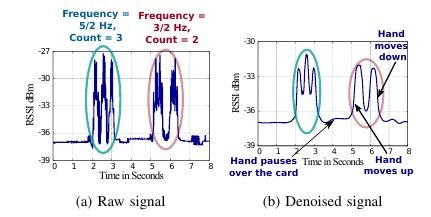WiGest: A WiFi-based Gesture Interface
February 05, 2015
on
on

In an effort to unglue people from their devices, computer scientists have developed a touchless interface. The gesture recognition system exploits changes in signal strength of a regular WiFi setup to control devices remotely.
WiGest is the result of an international collaboration involving three universities. Hebda Abdelnasser of Alexandria University, Moustafa Youssef hailing from the Egypt-Japan University of Science and Technology and Khaled A. Harras of Carnegie Mellon University developed a working prototype of the gesture recognition system that operates with 87.5 to 96% accuracy depending on the setup.
Many gesture interfaces on the market today utilize sensors such as camera's or motion sensors. Sensor-based interfaces have several limitations, Abdelnasser and his colleague's point out in their paper. They may require line-of-sight, work only with specific applications or devices and, well, depend on the sensor being installed on the device that is to be controlled.
WiFi has the advantage of being widely available both as a module on devices and as network infrastructure in homes and offices.
To make WiGest work the three scientists exploit changes in WiFi signal strength caused by hand gestures. A hand can move toward the controllable device, away from it or kept still, each gesture having a unique effect on the signal strength. Using several signal processing techniques the scientists were able to clean up the signal and use its characteristics as input.

Each gesture is mapped to a specific action. For instance, in an audio player, a downward hand movement triggers playing a song, while an upward movement stops it. Hand movements can be combined to allow for more input possibilities like up-down-up for skipping a song.
To make sure songs aren't skipped every time you move, WiGest only interprets gestures if they are preceded by a unique gesture pattern. This preamble also helps to reduce the number of false positives when the signal strength fluctuates due to environmental factors.
The lower bound 87.5% accuracy was accomplished with a WiFi setup of a single access point (AP). When the number of APs was increased to 3, accuracy improved to 96%.
Currently, Abdelnasser, Youssef and Harras are improving their system. They want WiGest to able to process more subtle gestures and have it work with other widely deployed wireless technologies like Bluetooth and cellular.
Via: technologyreview.com
WiGest is the result of an international collaboration involving three universities. Hebda Abdelnasser of Alexandria University, Moustafa Youssef hailing from the Egypt-Japan University of Science and Technology and Khaled A. Harras of Carnegie Mellon University developed a working prototype of the gesture recognition system that operates with 87.5 to 96% accuracy depending on the setup.
Many gesture interfaces on the market today utilize sensors such as camera's or motion sensors. Sensor-based interfaces have several limitations, Abdelnasser and his colleague's point out in their paper. They may require line-of-sight, work only with specific applications or devices and, well, depend on the sensor being installed on the device that is to be controlled.
WiFi has the advantage of being widely available both as a module on devices and as network infrastructure in homes and offices.
To make WiGest work the three scientists exploit changes in WiFi signal strength caused by hand gestures. A hand can move toward the controllable device, away from it or kept still, each gesture having a unique effect on the signal strength. Using several signal processing techniques the scientists were able to clean up the signal and use its characteristics as input.

Each gesture is mapped to a specific action. For instance, in an audio player, a downward hand movement triggers playing a song, while an upward movement stops it. Hand movements can be combined to allow for more input possibilities like up-down-up for skipping a song.
To make sure songs aren't skipped every time you move, WiGest only interprets gestures if they are preceded by a unique gesture pattern. This preamble also helps to reduce the number of false positives when the signal strength fluctuates due to environmental factors.
The lower bound 87.5% accuracy was accomplished with a WiFi setup of a single access point (AP). When the number of APs was increased to 3, accuracy improved to 96%.
Currently, Abdelnasser, Youssef and Harras are improving their system. They want WiGest to able to process more subtle gestures and have it work with other widely deployed wireless technologies like Bluetooth and cellular.
Via: technologyreview.com
Read full article
Hide full article



Discussion (0 comments)